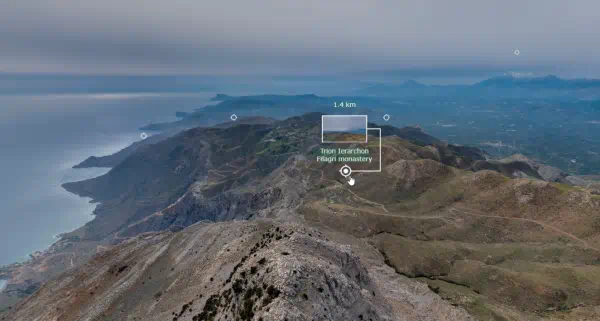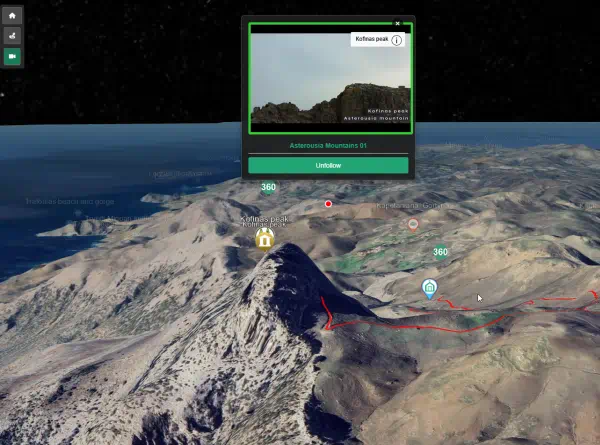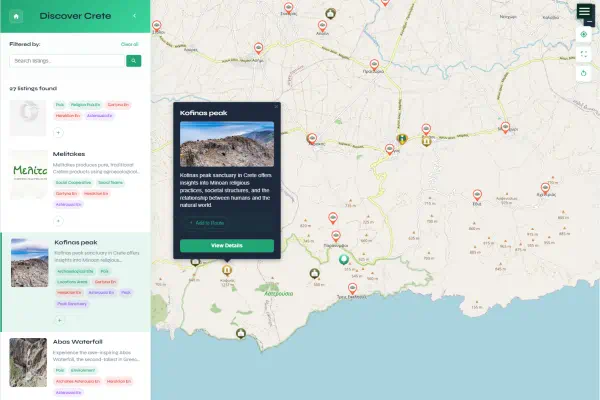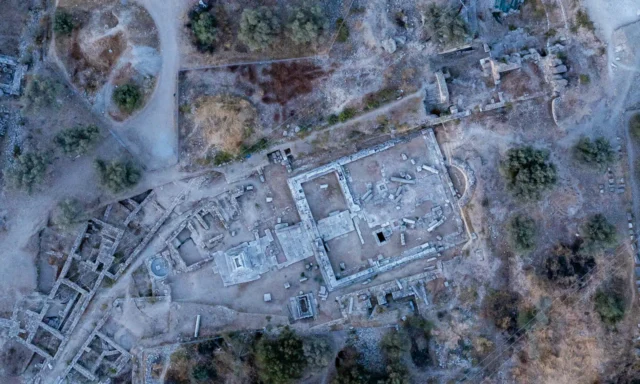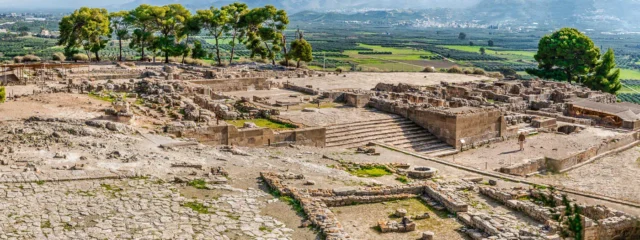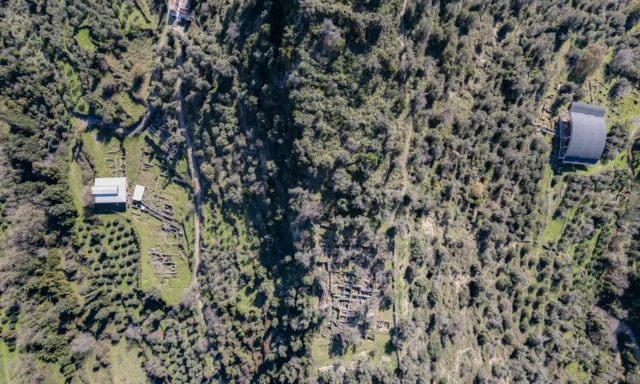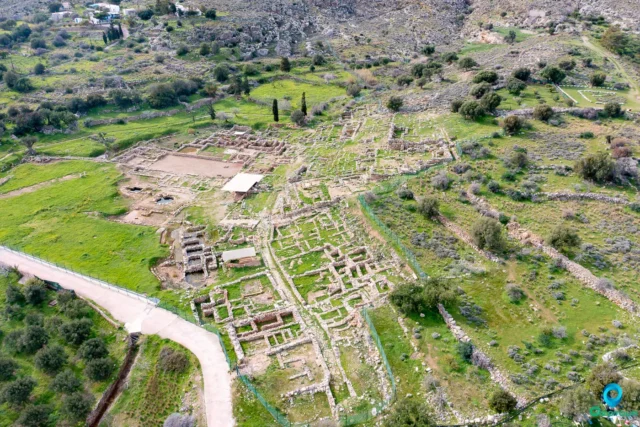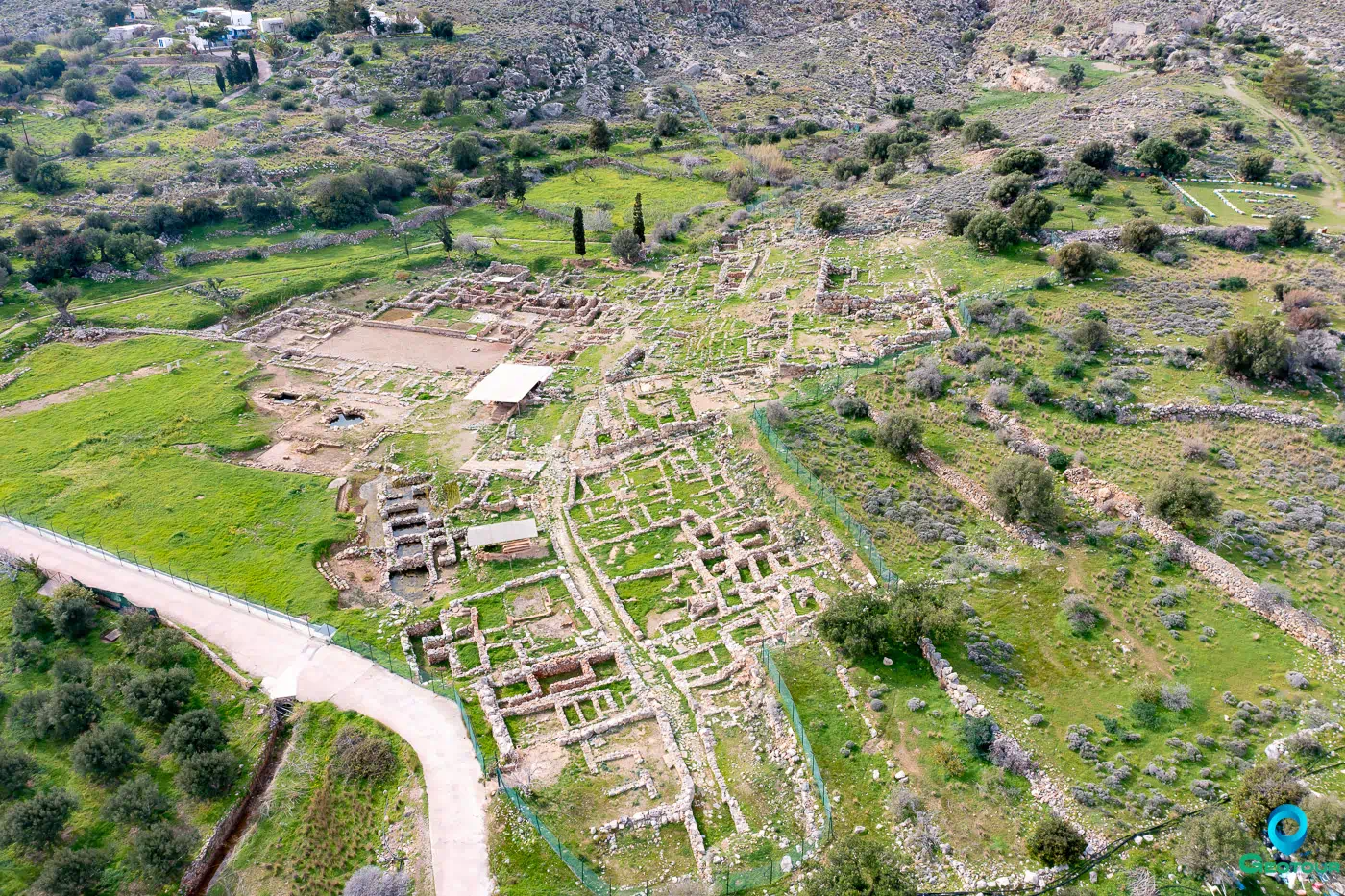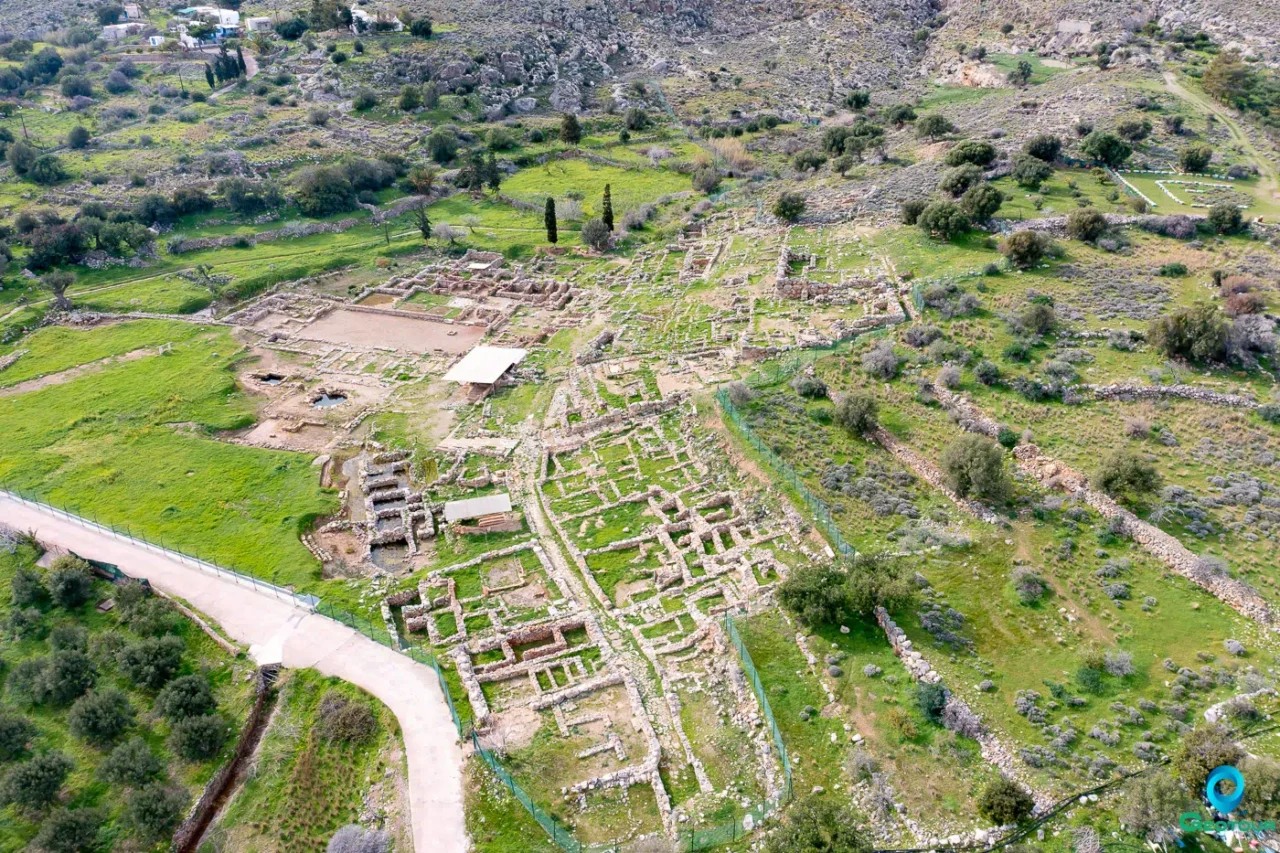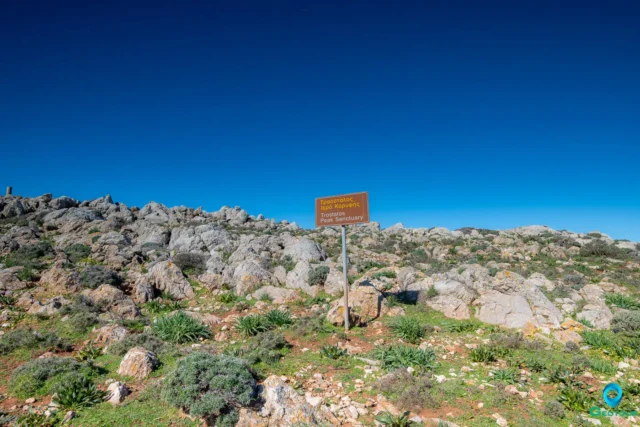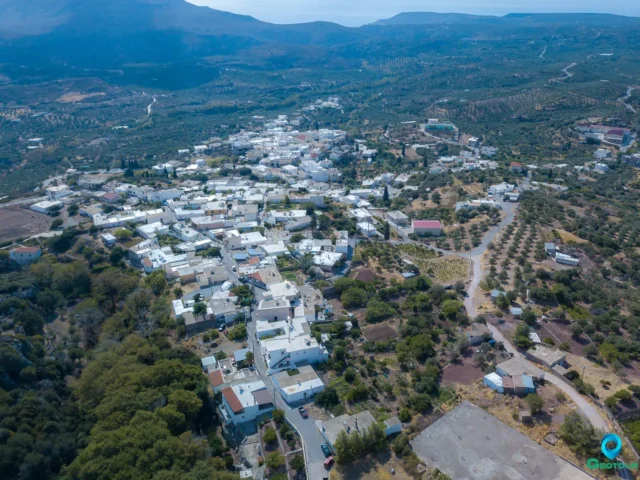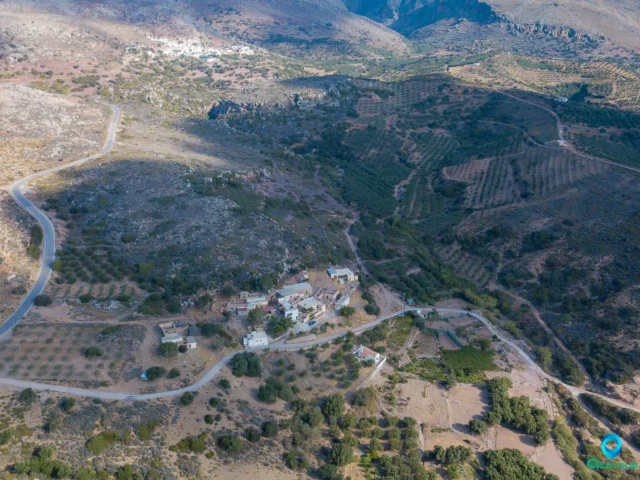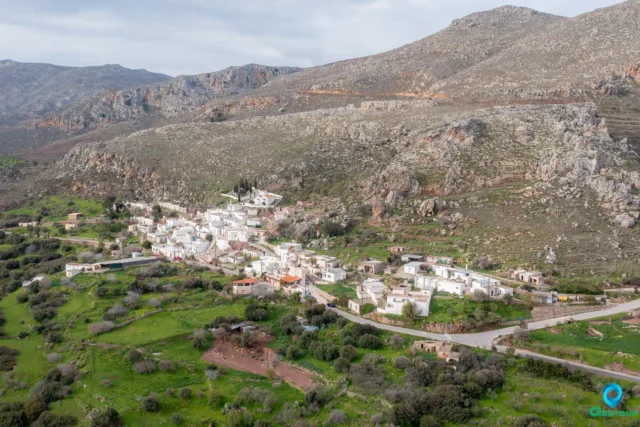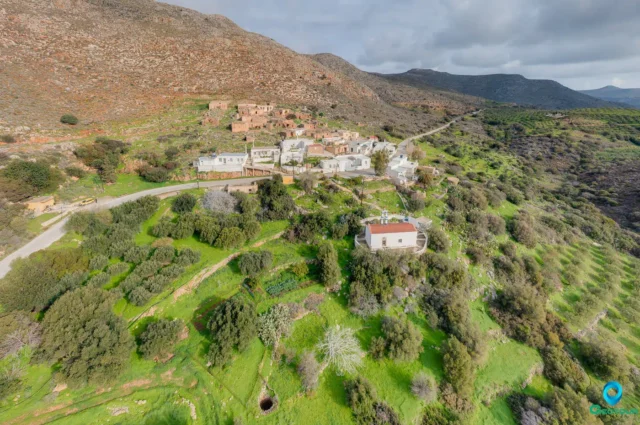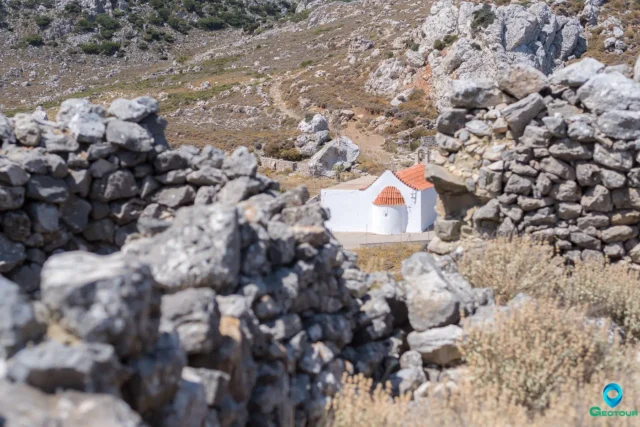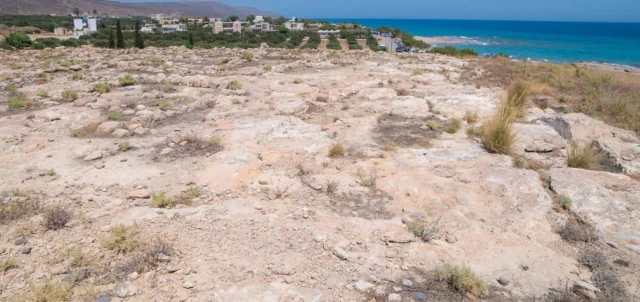The Minoan Palace of Zakros is in the valley of Zakros in eastern Crete, positioned between two hills. The Neopalatial settlement is on the slopes around the Late Minoan IB palace.
It is one of the Minoan palaces on the island of Crete.
Historical Periods
The Minoan Palace of Zakros, found in the valley of Zakros in eastern Crete, lies nestled between two hills, with the Neopalatial settlement located on the slopes surrounding it. Constructed during the Neopalatial period, the palace’s history came to an end with its destruction. The palace was built at the beginning of the Late Minoan IB period, and this period would also mark the end of the palace as the palace and the surrounding settlement were destroyed at the end of the LMIB period, seemingly by a forceful natural disaster. Later, the settlement of Zakros was abandoned either near the end of Late Minoan IIIA2 or at the start of Late Minoan IIIB.
Neolithic Habitation
Evidence indicates Neolithic habitation existed in the Zakros area. Specifically, Final Neolithic (FN) remains, including sherds and a significant amount of obsidian, have been identified on the northeast and southeast slopes of Kephala. The Traostalos peak sanctuary’s first use dates back to the Final Neolithic period.
Pelekita Cave, located 5km northeast of Kato Zakros, provides additional insights into the Neolithic period in this region. Excavations at Pelekita have unearthed finds dating primarily to the Minoan and Neolithic periods. The cave, also known as Sykiospilios, features five large chambers and a small pond in its deepest recesses. Although the immediate landscape around the cave is rocky, it could have been used for grazing and collecting wild plants. The fertile valley of Zakros, a few kilometers to the southwest, could have supported agriculture and more permanent dwellings.
The ceramic material recovered from Pelekita Cave suggests it is the oldest Neolithic site in southeastern Crete. The cave was most intensively used during the Late Neolithic period, around 5400/5300–4800/4700 BC, with some pieces possibly dating earlier (c. 5900 BC) and later (c. 4500/4300 BC). The ceramic assemblage is characterized by thin-walled, dark-colored surfaces ranging from black to brownish-black to blackish-gray, with well-burnished surfaces and fine to medium-fine fabric.
The transition from the Neolithic to the Early Bronze Age in Crete is a complex topic. Unstable settlement conditions, which reflect dramatic events and processes, are apparent during this time in the entire Aegean, not just Crete. The early FN period in Crete is characterized by the relocation of habitation sites to defensible hilltops, directly above previously exploited arable land. This relocation was likely due to growing insecurity rather than environmental factors or social development.
Minoan Period
The Minoan Period represents a significant era in the history of Zakros, with substantial archaeological evidence detailing its various phases and cultural developments. The Minoan Palace of Zakros was constructed during the Neopalatial period. The palace was built at the start of the Late Minoan IB period.
The palace covered 8,000 square meters, contained 150 rooms, and featured a Central Court that organized the palace into four wings. The design generally followed Minoan architectural conventions.
Protopalatial Period
During Hogarth’s investigations in Kato Zakros, twelve houses were unearthed on the slopes of the northeast hill. These houses were part of an extensive Minoan settlement that flourished during the Protopalatial Period. Large quantities of household furniture, pottery, and bronze tools, as well as deposits of clay sealings, were discovered within these houses. Agricultural installations, such as a winepress and a storeroom, along with various loom weights, were also found, as were burials.
Neopalatial Period
The Neopalatial settlement developed on the slopes of the hills surrounding the plain of the Late Minoan IB palace from the northeast, northwest, and southwest. The urban identity of the Neopalatial settlement at Kato Zakros has been suggested based on its morphological characteristics, including the extent of the site, evidence of planning, its layout, the existence of monumental structures, and other political, economic, and demographic parameters.
Nikolaos Platon identified buildings north of the palace as palatial annexes based on their monumental scale, orientation, spatial and functional relationship to the palace, as well as the quality and quantity of associated finds. Cunningham’s analysis of the evidence from Palaikastro provided an opportunity to reconsider the Zakros picture.
Late Minoan IB Period
The Kato Zakros settlement is known for the extent of its Late Minoan IB destruction horizon, providing sufficient evidence for in-depth discussions of individual buildings and the settlement as a whole. The palace in Kato Zakros was constructed at the beginning of LM IB and destroyed at the end of the same phase. This period is divided into two sub-phases based on the two destructions that occurred at the site, one during and another at the end of the LM IB.
Post-Palatial Period
After the main palace at Zakros wasn’t used anymore, people still lived on the site. Evidence of this re-occupation from the Late Minoan (LM) II-III periods is found in seven buildings across two small hills. At first, an archaeologist named Nikolaos Platon thought this re-settlement was short-lived and only happened during the Late Minoan (LM) IIIA2 period, based on the pottery he found.
However, more recent studies show that the area where people lived after the palace period, and how long they stayed at Zakros, was actually greater than Platon originally believed.
The history of Zakros at this time has seven stages. The sixth stage can be split into two parts. The first part, Zakros VIa, is when a small group of people came back to live in a few specific spots. This corresponds to the Late Minoan (LM) II and Late Minoan (LM) IIIA1 periods. The second part, Zakros VIb, matches the Late Minoan (LM) IIIA2 and the beginning of Late Minoan (LM) IIIB periods.
The settlement at Zakros after the palace was finally deserted at the end of the Late Minoan (LM) IIIA2 period, or, because of new finds in a destroyed building, possibly at a very early stage of Late Minoan (LM) IIIB.
History of Excavations
The archaeological exploration of Kato Zakros has a rich history, beginning with initial observations and leading to extensive excavations that have revealed significant insights into Minoan civilization.
Early interest in the area began in 1852 when British explorer A. B. Spratt identified the area of Kato Zakros as being of archaeological interest. Later, Hogarth’s discoveries would further stimulate interest by indicating the presence of a palatial center.
Systematic excavations at Kato Zakros began in 1901, led by D.G. Hogarth of the British School at Athens. Hogarth’s initial investigations unearthed twelve houses on the slopes of the northeast hill, which were part of an extensive Minoan settlement that flourished during the Protopalatial Period. These houses contained household furniture, pottery, bronze tools, and clay sealings. Despite these important finds, further excavation was not pursued for another sixty years.
In 1961, Nikolaos Platon commenced excavations, with financial support from Mr. and Mrs. L. Pomerance, close to Hogarth’s previously excavated area. Platon was convinced that he would reveal the fourth Minoan palace.
Later excavations and ongoing studies have contributed to the understanding of the site.
Notable Artifacts
- Clay Nodules with Seal Impressions: Hogarth’s excavation of House A yielded over 550 clay nodules with seal impressions. The seal faces impressed on the sealings of Kato Zakros have been published. 262 seal faces have been published because it also includes the five nodules found in the palace.
- Composite Representations: A group of images displaying composite representations are conspicuous among the nodules from House A.
- Other Artifacts: Besides the sealings, the excavations uncovered bronze implements, a stone lamp or altar, pottery, and a Linear A tablet. Other elaborate artifacts of Minoan art include the “Bull’s Head Rhyton” and the “Sanctuary Rhyton”.
Architectural Remains
- Settlement Layout: The Neopalatial settlement at Kato Zakros was built on the slopes of the hills surrounding the plain of the LM IB palace, from the northeast, northwest, and southwest. The streets run along axes perpendicular and vertical to the hill slopes, thus forming building blocks.
- Street Network: The street network had paved streets, steps alternating with ramps/terraces, small plateau-like squares, sidewalks, and a drainage system below street level. The plateau-like squares would facilitate the circulation of people and pack animals.
- Palace Design: The palace covered 8,000 square meters, contained 150 rooms, and featured a Central Court that organized the palace into four wings. Its design generally followed typical Minoan palatial architecture.
- West Wing: Devoted to religious activities, the west wing’s main entrance was opposite the altar in the court and included the Shrine, Treasury, Archive, Lustral Basin, storerooms, and other cult rooms.
- East Wing: The east wing contained the royal apartments of the king and queen with ceremonial halls and the hall of the cistern.
Zakros Minoan Palace in Crete: Key Points
- Construction Period: Old Palace (c. 1900 BC), New Palace (c. 1600 BC)
- Location: Eastern coast of Crete, Greece
- Dimensions: Approximately 8,000 square meters, 150 rooms
- Historical Significance: Major Minoan palace and trading hub
- Current State
- Limited Visitor Facilities: The site lacks visitor-associated structures, with only a tap available for watering plants.
- Inadequate Protection: Many sensitive areas lack adequate protective shelters, and existing structures are old and rusty. Visitors have limited places to sit and rest.
- Museum Exhibitions: Archaeological material from the palace and other sites are exhibited in Heraklion, Aghios Nikolaos, and Siteia museums. Note: The archaeological site at Zakros does not have extensive reconstructions.
References
- Odysseus Culture
- Minoan Crete
- Anastasiadou, M., 2016, Wings, Heads, Tails: Small Puzzles at LM I Zakros, in Metaphysis. Ritual, Myth and Symbolism in the Aegean Bronze Age (Aegaeum 39)
- Anastasiadou, M., n.d., Kato Zakros – The mobility of goods and the provisioning of buildings
- Anastasiadou, M., n.d., Kato Zakros – Towards an Identification of Residential and Economic Zones
- Germanidou, S., 2012, Honey Culture in Byzantium. Texts – Images – Finds, Athens
- Hatjina, F., Mavrofridis, G., Jones, R. (Eds.), 2014, Beekeeping in the Mediterranean From Antiquity to the Present, Chamber of Cyclades
- Nowicki, K., 2014, Final Neolithic Crete and the Southeast Aegean: Supplement 1
- Hamilakis, Y., Platon, L., 2018, Communities in Transition: The Circum-Aegean Area during the 5th and 4th Millennia BC
- Tsipopoulou, M., 2012, Introduction, 25 years Petras Excavations
- Vokotopoulos, L., 2019, Traostalos peak sanctuary Zakros

